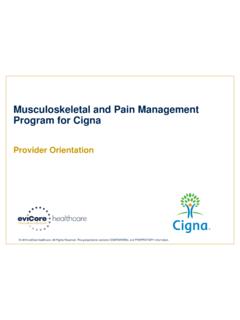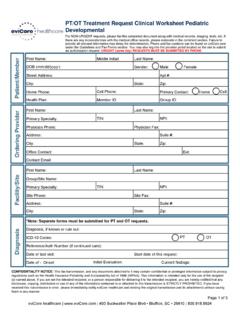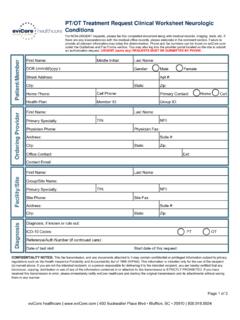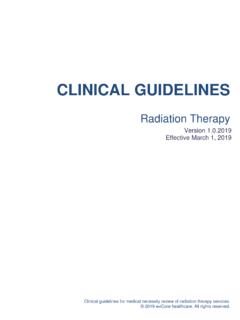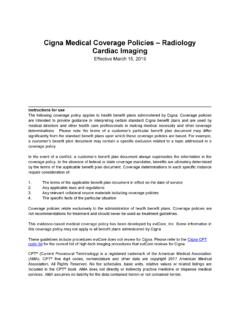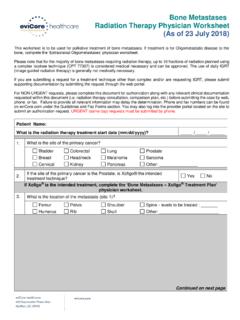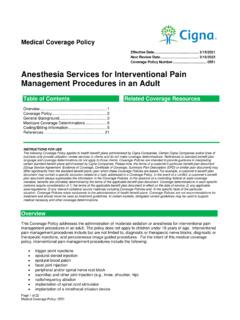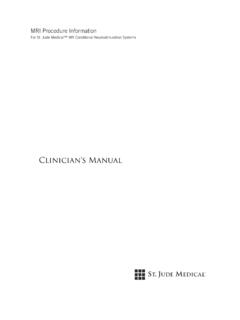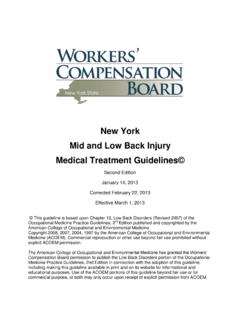Transcription of Cigna CMM-200 Epidural Steroid Injections - eviCore
1 Cigna Medical Coverage Policies Musculoskeletal Epidural Steroid Injections Effective July 01, 2021 Instructions for use The following coverage policy applies to health benefit plans administered by Cigna . Coverage policies are intended to provide guidance in interpreting certain standard Cigna benefit plans and are used by medical directors and other health care professionals in making medical necessity and other coverage determinations. Please note the terms of a customer s particular benefit plan document may differ significantly from the standard benefit plans upon which these coverage policies are based.
2 For example, a customer s benefit plan document may contain a specific exclusion related to a topic addressed in a coverage policy. In the event of a conflict, a customer s benefit plan document always supersedes the information in the coverage policy. In the absence of federal or state coverage mandates, benefits are ultimately determined by the terms of the applicable benefit plan document. Coverage determinations in each specific instance require consideration of: 1. The terms of the applicable benefit plan document in effect on the date of service 2. Any applicable laws and regulations 3. Any relevant collateral source materials including coverage policies 4.
3 The specific facts of the particular situation Coverage policies relate exclusively to the administration of health benefit plans. Coverage policies are not recommendations for treatment and should never be used as treatment guidelines. This evidence-based medical coverage policy has been developed by eviCore , Inc. Some information in this coverage policy may not apply to all benefit plans administered by Cigna . CPT (Current Procedural Terminology) is a registered trademark of the American Medical Association (AMA). CPT five digit codes, nomenclature and other data are copyright 2020 American Medical Association.
4 All Rights Reserved. No fee schedules, basic units, relative values or related listings are included in the CPT book. AMA does not directly or indirectly practice medicine or dispense medical services. AMA assumes no liability for the data contained herein or not contained herein. Copyright 2021 eviCore healthcareCMM-200: Epidural Steroid Injections (ESI)Definitions Transforaminal Epidural Steroid injection (TFESI) is a therapeutic injection ofcontrast (absent allergy to contrast) performed at a single or multiple spinal levelsfollowed by the introduction of a corticosteroid and possibly a local anesthetic byinserting a needle into the neuroforamen under fluoroscopic or computedtomography (CT) guidance.
5 Selective Nerve Root Block (SNRB) is a diagnostic injection of contrast (absentallergy to contrast) of a single nerve root to assist with surgical planning followed bythe introduction of a local anesthetic by inserting a needle into the neuroforamenunder fluoroscopic or computed tomography (CT) guidance. SNRBs are erroneouslyreferred to as a Transforaminal Epidural Steroid Injection (TFESI), althoughtechnically SNRBs involve the introduction of anesthetic only and are used fordiagnostic purposes. Selective nerve root blocks (SNRBs) performed for the purpose of treating pain( , repeat SNRB at the same level) may be termed therapeutic selective nerve root blocks.
6 There is insufficient evidence to support the clinical utility of therapeutic selective nerve root bocks (SNRBs). Interlaminar Epidural Steroid injection (ILESI) is an injection of contrast, (absentallergy to contrast), followed by the introduction of a corticosteroid and possibly alocal anesthetic into the Epidural space of the spine either through a paramedian ormidline interlaminar approach under fluoroscopic guidance. Caudal Epidural Steroid injection (CESI) is an the injection of contrast, (absentallergy to contrast), followed by the introduction of corticosteroids and possibly alocal anesthetic into the Epidural space of the spine by inserting a needle throughthe sacral hiatus under fluoroscopic guidance into the Epidural space at the sacralcanal.
7 Radiculopathy, for the purpose of this policy, is defined as the presence of pain,dysaesthesia(s), or paraesthesia(s) reported by the individual in a level-specificreferral pattern of an involved named spinal root(s), causing significant functionallimitations resulting in diminished quality of life and impaired age-appropriateactivities of daily living, and EITHER of the following: Documentation of ONE or MORE of the following, concordant with nerve rootcompression of the involved named spinal root(s) demonstrated on a detailed neurologic examination within the prior three (3) months: Loss of strength of specific named muscle(s) or myotomal distribution(s) Altered sensation to light touch, pressure, pin prick or temperature Diminished, absent or asymmetric reflex(es) Documentation of EITHER of the following performed within the prior 24 months: A concordant radiologist s interpretation of an advanced diagnostic imaging study (MRI or CT) of the spine demonstrating compression of the involved named spinal nerve root(s) or foraminal stenosis at the concordant level(s) Comprehensive Musculoskeletal Management Guidelines _____ 2021 eviCore healthcare.
8 All Rights Reserved. 400 Buckwalter Place Boulevard, Bluffton, SC 29910 (800) 918-8924 Page 2 of 15 Epidural Steroid Injections (ESI) Electrodiagnostic studies (EMG/NCV s) diagnostic of nerve root compression of the involved named spinal nerve root(s). Radicular pain is pain which radiates to the extremity along the course of a spinalnerve root, typically resulting from compression, inflammation, and/or injury to thenerve root. Radiculitis is defined, for the purpose of this policy, as radicular pain withoutobjective neurological findings on physical examination. Spinal stenosis refers to the narrowing of the spinal canal usually due to spinaldegeneration that occurs with aging.
9 It may also be the result of spinal discherniation, osteoarthritis or a tumor. Lumbar spinal stenosis results in low back painas well as pain or abnormal sensations in the legs, thighs, feet or buttocks, or loss ofbladder and bowel control. Neurogenic claudication is often a clinical condition thatresults from spinal Guidelines This guideline does not apply to Epidural Injections administered for obstetrical or surgical Epidural anesthesia or for perioperative pain management. This policy only applies to the injection of anesthetic, corticosteroid, and/or contrast agent as defined in this policy and not to other injectates, including but not limited to the following: Spinraza, chemotherapy, neurolytic substances, antispasmodics, antibiotics, antivirals, biologics ( , platelet rich plasma, stem cells, amniotic fluid, etc.)
10 , and any other injectates. The determination of medical necessity for the performance of a diagnostic selectivenerve root block (SNRB) or a therapeutic Epidural Steroid injection (ESI) is alwaysmade on a case-by-case basis. An Epidural Steroid injection (ESI) should be performed with the use of fluoroscopicor CT guidance and the injection of a contrast, with the exception of an emergentsituation or when fluoroscopic/CT guidance or the injection of contrast iscontraindicated ( , pregnancy). The use of an indwelling catheter to administer a continuous infusion/intermittentbolus should be limited to use in a hospital setting only.
